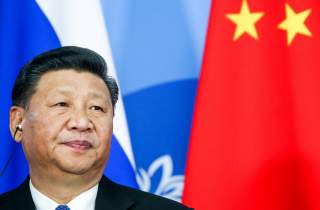Another Long Peace?
The likelihood of limited war and instability is higher in a new U.S.-China bipolar system in the twenty-first century compared to the old U.S.-Soviet Union bipolar system of the twentieth century.
Contemporary China remains concerned with its regional ambitions in East Asia, where it challenges the existing status quo and spheres of influence, protects its sovereignty claims in maritime East Asia, expands its presence at land and at sea, and seeks to establish a security buffer at sea by emphasizing the development of anti-access and area denial capabilities. Since East Asia does not resemble the East-West divide in Europe, a revisionist China is likely to be preoccupied with dominating the region and pushing the United States out of East Asian waters. In contrast, the Soviet Union was geopolitically rewarded in the post-World War II era and less interested in contending for regional hegemony in Europe.
There are fewer power vacuums to fill and less geographical space for China’s global interests to expand into. This explains why the U.S.-China rivalry and conflict on the global stage is evolving more gradually, and why China is more likely to focus on safeguarding and expanding its interests in East Asia. The shift from multipolarity to bipolarity in the post-World War II period saw traditional great powers like France and Britain lose their top-ranking position, opening the way for colonial revolutions, decolonization, civil wars and power vacuums. The two new post-World War II superpowers embarked on an intense decades-long rivalry to fill the power vacuums and gain influence in the numerous new states to appear. Colonial revolutions and decolonization created, in the words of Morgenthau, “a moral, military, and political no-man’s land neither completely nor irrevocable committed to either side.” The faith of the new “uncommitted nations,” whether they aligned themselves politically and militarily with the United States or the Soviet Union, sparked superpower rivalry on the global stage and created the two blocs and Non-Aligned Movement of the Cold War.
TODAY, NO empires are dissolving, there are no comparable colonial revolutions worldwide or power vacuums to fill. There are failed states and power vacuums in the contemporary world, but the instability in Africa, the Near and Middle East, Afghanistan and Latin America is not comparable with the instability in the aftermath of World War II and the decline of the traditional great powers. There is less geopolitical space for the superpowers to be pulled into and fewer newly developed states where the new superpower can compete for influence globally. Stability in Europe and power vacuums globally gave the Soviet Union an opportunity to compete globally with the United States despite the asymmetric power relationship between the Soviet Union and the United States. Instability in East Asia and smaller power vacuums globally prevent China from emulating the Soviet Union’s intervention globally.
In examining and predicting whether China and the United States will avoid the pattern of conflict and wars that marked the rise and the fall of great powers in the past, we need to establish whether China and the United States will be peer competitors within a bipolar or a multipolar system. This will affect the risk of war, stability, their pattern of behavior and how a new world order will be constructed. A bipolar system is a system in which no third power can challenge the top two. Not only has the unprecedented power shift during the last decade elevated China to superpower status, China’s leaders are now referring to a new era. China has risen well above the so-called BRICs emerging economies and has only one peer competitor: the United States.
The features of the previous bipolar system were stability, strong balancing, and strong competition and rivalry at the periphery. The contemporary bipolar system is characterized by instability, moderate balancing, and limited competition and rivalry at the periphery. A bipolar system concentrated on maritime East Asia in the twenty-first century is likely to be more unstable and prone to limited war than the bipolar system concentrated on continental Europe was in the twentieth century. Instability at the power center in East Asia is likely to foster more stability at the periphery than during the previous bipolar era since the superpowers are more likely to be preoccupied with rivalry in maritime East Asia and less likely to be involved in proxy wars in other regions. The new bipolar system is not destined for another “long peace.” While nothing is preordained in world politics, and the new structural conditions can be resisted, they are likely to push the United States and China toward a limited war for the control and access to sea-lanes in maritime East Asia.
Øystein Tunsjø is professor at the Norwegian Defence University College and the Norwegian Institute for Defence Studies. Tunsjø’s recent book is The Return of Bipolarity in World Politics: China, the United States and Geostructural Realism (Columbia University Press, 2018). Tunsjø holds a PhD in International Relations from the University of Wales, Aberystwyth and was a visiting Fulbright scholar at the Fairbank Center for Chinese Studies, Harvard University in 2010.
Image: Reuters

